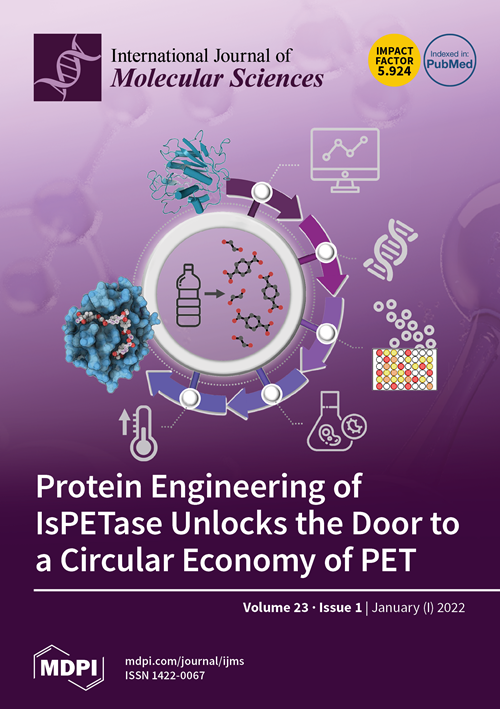Serum Calretinin and Genetic Variability as a Prognostic and Predictive Factor in Malignant Mesothelioma
IF 4.9
2区 生物学
Q1 BIOCHEMISTRY & MOLECULAR BIOLOGY
引用次数: 0
Abstract
Calretinin is a promising diagnostic biomarker for malignant mesothelioma (MM), but less is known about its prognostic role. Our aim was to evaluate the association between serum calretinin concentration or genetic factors and the survival or outcome of cisplatin-based chemotherapy in MM. Our study included 265 MM patients. Serum calretinin concentration was determined using ELISA. Patients were genotyped for seven polymorphisms in CALB2, E2F2, MIR335, NRF1, and SEPTIN7 using competitive allele-specific PCR. Nonparametric tests, logistic regression, and survival analysis were used for statistical analysis. Higher serum calretinin concentration was associated with shorter progression-free (PFS) (HR = 1.18 (1.02–1.37), p = 0.023) and overall survival (OS) (HR = 1.20 (1.03–1.41), p = 0.023), but the association was not significant after adjusting for clinical factors (HR = 1.05 (0.85–1.31), p = 0.653 and HR = 1.06 (0.84–1.34), p = 0.613, respectively). SEPTIN7 rs3801339 and MIR335 rs3807348 were associated with survival even after adjustment (HR = 1.76 (1.17–2.64), p = 0.007 and HR = 0.65 (0.45–0.95), p = 0.028, respectively). Calretinin concentration was higher in patients who progressed after treatment with cisplatin-based chemotherapy (1.68 vs. 0.45 ng/mL, p = 0.001). Calretinin concentration above 0.89 ng/mL was associated with shorter PFS and OS from the start of chemotherapy (HR = 1.88 (1.28–2.77), p = 0.001 and HR = 1.91 (1.22–2.97), p = 0.004, respectively), even after adjusting for clinical factors (p < 0.05). MIR335 rs3807348 was associated with a better response to chemotherapy (OR = 2.69 (1.17–6.18), p = 0.020). We showed that serum calretinin is associated with survival and chemotherapy treatment outcomes in MM and could serve as a predictive biomarker.作为恶性间皮瘤预后和预测因素的血清钙凝蛋白和基因变异性
钙网蛋白是一种很有前景的恶性间皮瘤(MM)诊断生物标志物,但人们对其预后作用的了解较少。我们的目的是评估血清钙黄绿素浓度或遗传因素与MM的生存或顺铂化疗结果之间的关联。我们的研究纳入了 265 名 MM 患者。使用酶联免疫吸附法测定血清钙黄绿素浓度。使用竞争性等位基因特异性 PCR 对患者进行了 CALB2、E2F2、MIR335、NRF1 和 SEPTIN7 七种多态性的基因分型。统计分析采用了非参数检验、逻辑回归和生存分析。较高的血清钙黄绿素浓度与较短的无进展生存期(PFS)(HR = 1.18 (1.02-1.37),p = 0.023)和总生存期(OS)(HR = 1.20 (1.03-1.41),p = 0.023)相关,但在调整临床因素后,相关性并不显著(分别为 HR = 1.05 (0.85-1.31),p = 0.653 和 HR = 1.06 (0.84-1.34),p = 0.613)。即使经过调整,SEPTIN7 rs3801339 和 MIR335 rs3807348 仍与生存率相关(分别为 HR = 1.76 (1.17-2.64),p = 0.007 和 HR = 0.65 (0.45-0.95),p = 0.028)。顺铂化疗后病情进展的患者钙网蛋白浓度更高(1.68 vs. 0.45 ng/mL,p = 0.001)。即使调整了临床因素(p < 0.05),钙网蛋白浓度高于 0.89 ng/mL 与化疗开始后较短的 PFS 和 OS 相关(分别为 HR = 1.88 (1.28-2.77),p = 0.001 和 HR = 1.91 (1.22-2.97),p = 0.004)。MIR335 rs3807348与更好的化疗反应相关(OR = 2.69 (1.17-6.18),p = 0.020)。我们的研究表明,血清钙黄绿素与 MM 的生存和化疗疗效相关,可作为一种预测性生物标志物。
本文章由计算机程序翻译,如有差异,请以英文原文为准。
求助全文
约1分钟内获得全文
求助全文
来源期刊

International Journal of Molecular Sciences
Chemistry-Organic Chemistry
CiteScore
8.10
自引率
10.70%
发文量
13472
审稿时长
17.49 days
期刊介绍:
The International Journal of Molecular Sciences (ISSN 1422-0067) provides an advanced forum for chemistry, molecular physics (chemical physics and physical chemistry) and molecular biology. It publishes research articles, reviews, communications and short notes. Our aim is to encourage scientists to publish their theoretical and experimental results in as much detail as possible. Therefore, there is no restriction on the length of the papers or the number of electronics supplementary files. For articles with computational results, the full experimental details must be provided so that the results can be reproduced. Electronic files regarding the full details of the calculation and experimental procedure, if unable to be published in a normal way, can be deposited as supplementary material (including animated pictures, videos, interactive Excel sheets, software executables and others).
 求助内容:
求助内容: 应助结果提醒方式:
应助结果提醒方式:


